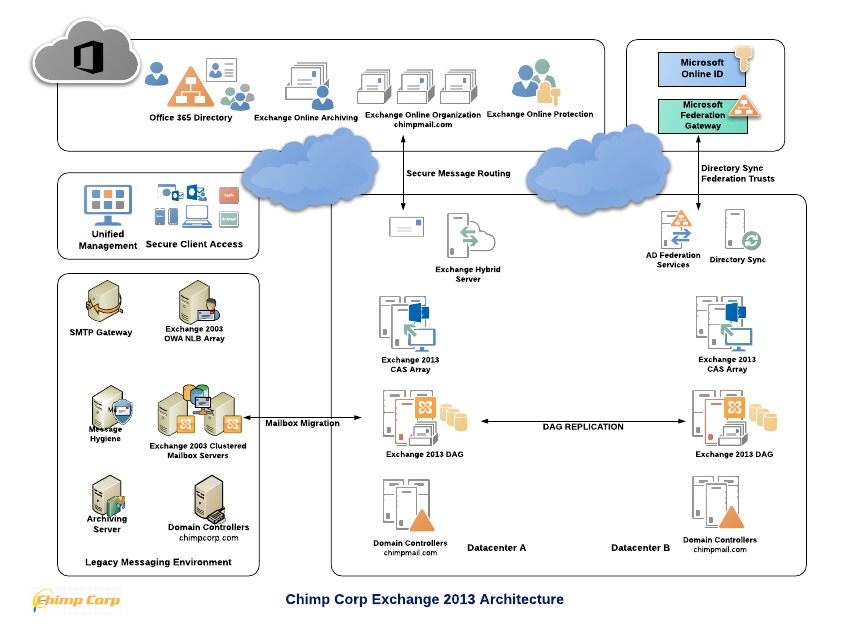Overview
In this part of the Sample Architecture Series, we will hone in on several elements of the Exchange Solution design, namely a description of the overall Exchange 2013 solution design, followed by some basic system configuration parameters as well as virtualization considerations.
Design Features
The Exchange 2013 Environment for Chimp Corp features the following design elements:
- Internal Client Access: Internal clients can automatically locate and connect to available CAS Servers through the Availability and Autodiscover services. CAS Servers are configured in arrays for high-availability and the locations of the CAS servers are published through Service Connection Points (SCPs) in Active Directory.
- External Client Access: External clients can connect to Exchange via Outlook Web Access (OWA), Outlook Anywhere and Exchange ActiveSync. Exchange 2013 now supports L4 load balancing for stateless failover of connections between CAS servers in the same Array. Client traffic arrives at the Network Load Balancer, which uses Service Connection Points to locate the internal Mailbox servers and distribute load accordingly.
- Single Domain Name URL: Exchange 2013 relies on a feature in the TCP/IP protocol stack of client computers that supports the caching of multiple IP addresses that correspond to the same name resolved from DNS. In the event of an individual site failure, the IP address corresponding to the CAS array in that site will become unresponsive. Clients automatically connect to the next cached IP address for the CAS Array in order to reestablish client connections. This IP address corresponds to the CAS Servers in the alternative site and failover occurs without any intervention.
- Mailbox High availability: This feature is provided by implementing Database Availability Groups (DAG). A single DAG will be configured to protect the messaging service. It is preferred to deploy a high number of smaller mailbox databases in order to reduce mailbox restoration or reseed times in the event of a failure of a database copy.
- Message Routing: All External SMTP traffic will be routed securely via Microsoft’s Exchange Online Protection (EOP) cloud-based services and the Internet. Inter-site messages between the premise and online users will also be routed via EOP. Internal messages between on-premise users in either datacenter site will be routed automatically via the transport service on the on-premise Mailbox servers.
- Hybrid Deployment: The Exchange 2013 environment will be deployed in tandem with an Exchange Online Organization. The purpose of the Exchange Online Organization will be to host mailbox accounts that have been flagged as non-compliance sensitive and reduce the costs of the on-premises deployment. The hybrid implementation will feature a seamless experience between users in the on-premise and online environments, including Single Sign-on for users through the configuration of trusts between the Microsoft Online ID and the on-premises Active Directory Forest; unified GAL access and the ability for online and on-premise users to share free/busy information through the configuration of a Federation Trust with the Microsoft Federation Gateway; as well as secure encrypted message transport between on-premise and online environments, encrypted, authenticated and transported via Transport Layer Security (TLS)
- Message Archiving: All Messages will be transferred to the Exchange 2013 via the Exchange Online Archiving Service. The existing on-premises archiving solution will be decommissioned after existing message archives are ingested into the Exchange Online Archive.
Exchange 2013 Virtualization
All Exchange 2013 server roles are fully supported for virtualization by Microsoft. Virtualization can assist an organization in consolidating its computing workload and enjoying benefits from cost reduction and efficient hardware resource utilization. According to Microsoft recommended Best Practices, load calculations when provisioning Exchange deployments in a virtual environment must accommodate for additional overheads from the virtualization hypervisor. Therefore, this solution design has factored in an additional resource overhead of 12% to accommodate virtualization.
The following server roles will be virtualized:
- Exchange 2013 Mailbox Servers
- Exchange 2013 CAS Servers
Microsoft provides further guidance on implementing Exchange Server 2013 in a virtualized environment. Relevant factors have been listed below:
- Exchange Servers may be combined with virtual host-based failover clustering migration technology, provided that the virtual machines are configured to not save and restore disk state when moved or taken offline. Host-based failover must result in a cold boot when the virtual machine is activated on a target node.
- The root machine should be free of all applications save the virtual hypervisor and management software.
- Microsoft does not support taking a snapshot of an Exchange virtual machine.
- Exchange supports a Virtual Processor to Physical Processor ratio of no greater than 2:1 and Microsoft recommends an ideal processor ratio of 1:1. Furthermore, virtual CPUs required to run the host OS should be included in the processor ratio count
- The disk size allocated to each Exchange Virtual machine must use a disk that is of size equal to 15GB plus the size of virtual memory allocated to the virtual server.
- The storage allocated for Exchange data can either be virtual storage of a fixed site, such as fixed Virtual Hard Disks (VHDs), SCSI pass-through storage or iSCSI storage.
- Exchange 2013 does not support NAS storage. However, fixed VHDs that are provisioned on block level storage and accessed via SMB 3.0 on Windows Server 2012 Hyper-V are supported.
- Exchange 2013 is designed to make optimal usage of memory allocations and as such, dynamic memory features for Exchange are not supported.
Conclusion
Subsequent sections of this series will focus on the Exchange Mailbox Design and CAS Design, as well as the Hybrid Implementation and additional features.
Please click here for the next part: Exchange 2013 Mailbox Server Role Design.


Why use virtual servers rather than physical ?
“Microsoft recommends an ideal Virtual to Physical Processor ratio ratio of 1:1. Furthermore, virtual CPUs required to run the host OS should be included in the processor ratio count.” This would seem to eliminate any consolidation benefit normally expected from virtualisation.